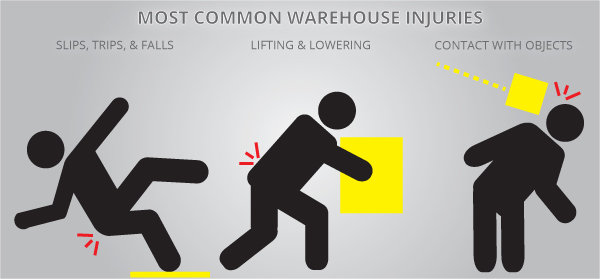We use cookies to make your experience better. To comply with the new e-Privacy directive, we need to ask for your consent to set the cookies. Learn more.
The Most Common Warehouse Injuries - and How to Prevent Them
Let's start with the good news: Injury rates in the warehousing industry began to dip in recent years. Employers in that sector reported fewer injuries and illnesses in 2015 than the prior year, reports the Bureau of Labor Statistics. Fewer material handling workers lost their lives in accidents in 2015, as well.

The bad news is that injuries still occur. In fact, compared to other workplaces, warehouses remain excellent places to get hurt. In 2015, there were 5 recordable cases of injury or illness for every 100 workers in the warehousing and storage industry, according to the BLS.
To make matters worse, injuries are often more serious in warehouses than other workplaces. The BLS shows that people injured in this sector spent a median of 20 days away from work while recuperating. That's well above the median recovery days for all industries, which number only 8.
Of course, the first step to preventing these injuries is to understand what's causing them. To that end, here are the three most common causes of injuries requiring days off in the warehousing industry, along with a few tips to help keep injury statistics low in the coming year:
1. Slips, trips, and falls.
In 2015, the incidence rate for slips and falls for material handling staff was 51.4 per 10,000 full-time workers. Compare that to the incidence rate for all industries, which was just 27.9 per 10,000 full-time workers. It's clear that something needs to be done in the nation's warehouses.Start by reviewing the OSHA standards, particularly 29 CFR 1910 Subpart D, which covers walking-working surfaces. "Aisles and passageways shall be kept clear and in good repairs, with no obstruction across or in aisles that could create a hazard," the standard reads.
Additionally, "covers and/or guardrails shall be provided to protect personnel from the hazards of open pits, tanks, vats, ditches, etc." Essentially, any raised space that staff could fall from should be protected with Structural Barrier Rails.
2. Overexertion in lifting and lowering.
Ergonomics has taken the material handling world by storm, and not a moment too soon. With a 2015 incidence rate of 25.2 per 10,000 workers, injuries due to overexertion frustrate safety advocates because they are so preventable.The best way to keep staff from injuring themselves trying to handle heavy loads is to simply provide lifting equipment. Depending on the materials involved, Lift Tables or Bin Dumpers take the load from human shoulders, eliminating the risk of injury.
3. Contact with objects and equipment.
This is another leading cause of warehouse injuries, with 40.1 recordable injuries per 10,000 workers in 2015. But what exactly does it mean?Any time an employee runs into an object or piece of machinery, that's counted as "contact." The object might fall, like a tool dropped from a mezzanine, be propelled, like a flying damaged gas cylinder, or it might stand still while a worker crashes into it.
There are a few good ways to prevent this type of injury: Label everything in sight with adequate and noticeable signage, and make sure all warehouse equipment is in perfect working order. Follow OSHA rules, and equip all elevated platforms with toe guards to keep tools from slipping over the edge.
Both ethics and the law require employers to establish safe workplaces, but investing in safety can also create tangible financial gains. Employees are more likely to stick around when the working environment is pleasant. When employers take steps to prevent injuries, morale will improve, and with it, efficiency.
Besides, think of all those workdays employees miss when they're recovering from an injury. In 2015 alone, the transportation and warehousing industry lost nearly 100,000 days of productivity due to injuries or illnesses requiring time off. That's no way to run an efficient operation.
Even when your bottom line is the top priority, it pays to put safety first.
References:
“Employer-Reported Workplace Injuries and Illnesses - 2015.” BLS. Bureau of Labor Statistics, United States Department of Labor, 27 Oct. 2016. PDF. 4 Jan. 2017.
“National Census of Fatal Occupational Injuries in 2015.” BLS. Bureau of Labor Statistics, United States Department of Labor, 16 Dec. 2016. PDF. 4 Jan. 2017.
“Nonfatal Occupational Injuries and ILlnesses Requiring Days Away From Work, 2015.” BLS. Bureau of Labor Statistics, United States Department of Labor, 10 Nov. 2016. PDF. 4 Jan. 2017.
“Walking-Working Surfaces, General Requirements - 1910 Subpart D.” OSHA. Occupational Safety and Health Administration, United States Department of Labor, n.d. Web. 4 Jan. 2017.
